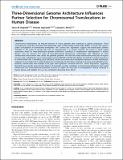| dc.contributor.author | Engreitz, Jesse Michael | |
| dc.contributor.author | Agarwala, Vineeta | |
| dc.contributor.author | Mirny, Leonid A. | |
| dc.date.accessioned | 2013-01-28T14:59:30Z | |
| dc.date.available | 2013-01-28T14:59:30Z | |
| dc.date.issued | 2012-09 | |
| dc.date.submitted | 2012-04 | |
| dc.identifier.issn | 1932-6203 | |
| dc.identifier.uri | http://hdl.handle.net/1721.1/76617 | |
| dc.description.abstract | Chromosomal translocations are frequent features of cancer genomes that contribute to disease progression. These rearrangements result from formation and illegitimate repair of DNA double-strand breaks (DSBs), a process that requires spatial colocalization of chromosomal breakpoints. The “contact first” hypothesis suggests that translocation partners colocalize in the nuclei of normal cells, prior to rearrangement. It is unclear, however, the extent to which spatial interactions based on three-dimensional genome architecture contribute to chromosomal rearrangements in human disease. Here we intersect Hi-C maps of three-dimensional chromosome conformation with collections of 1,533 chromosomal translocations from cancer and germline genomes. We show that many translocation-prone pairs of regions genome-wide, including the cancer translocation partners BCR-ABL and MYC-IGH, display elevated Hi-C contact frequencies in normal human cells. Considering tissue specificity, we find that translocation breakpoints reported in human hematologic malignancies have higher Hi-C contact frequencies in lymphoid cells than those reported in sarcomas and epithelial tumors. However, translocations from multiple tissue types show significant correlation with Hi-C contact frequencies, suggesting that both tissue-specific and universal features of chromatin structure contribute to chromosomal alterations. Our results demonstrate that three-dimensional genome architecture shapes the landscape of rearrangements directly observed in human disease and establish Hi-C as a key method for dissecting these effects. | en_US |
| dc.description.sponsorship | National Human Genome Research Institute (U.S.) (grant T32 HG002295) | en_US |
| dc.description.sponsorship | United States. Dept. of Defense (National Defense Science and Engineering Graduate Fellowship Program) | en_US |
| dc.description.sponsorship | Fannie and John Hertz Foundation | en_US |
| dc.description.sponsorship | National Institute of General Medical Sciences (U.S.) (grant 5T32 GM008313) | en_US |
| dc.description.sponsorship | National Institute of General Medical Sciences (U.S.) (Medical Scientist Training Program) | en_US |
| dc.language.iso | en_US | |
| dc.publisher | Public Library of Science | en_US |
| dc.relation.isversionof | http://dx.doi.org/10.1371/journal.pone.0044196 | en_US |
| dc.rights | Creative Commons Attribution | en_US |
| dc.rights.uri | http://creativecommons.org/licenses/by/2.5/ | en_US |
| dc.source | PLoS | en_US |
| dc.title | Three-Dimensional Genome Architecture Influences Partner Selection for Chromosomal Translocations in Human Disease | en_US |
| dc.type | Article | en_US |
| dc.identifier.citation | Engreitz, Jesse M., Vineeta Agarwala, and Leonid A. Mirny. “Three-Dimensional Genome Architecture Influences Partner Selection for Chromosomal Translocations in Human Disease.” Ed. Shawn Ahmed. PLoS ONE 7.9 (2012): e44196. Web. | en_US |
| dc.contributor.department | Harvard University--MIT Division of Health Sciences and Technology | en_US |
| dc.contributor.department | Massachusetts Institute of Technology. Department of Physics | en_US |
| dc.contributor.mitauthor | Engreitz, Jesse Michael | |
| dc.contributor.mitauthor | Agarwala, Vineeta | |
| dc.contributor.mitauthor | Mirny, Leonid A. | |
| dc.relation.journal | PLoS One | en_US |
| dc.eprint.version | Final published version | en_US |
| dc.type.uri | http://purl.org/eprint/type/JournalArticle | en_US |
| eprint.status | http://purl.org/eprint/status/PeerReviewed | en_US |
| dspace.orderedauthors | Engreitz, Jesse M.; Agarwala, Vineeta; Mirny, Leonid A. | en |
| dc.identifier.orcid | https://orcid.org/0000-0002-5754-1719 | |
| dc.identifier.orcid | https://orcid.org/0000-0002-0785-5410 | |
| mit.license | PUBLISHER_CC | en_US |
| mit.metadata.status | Complete | |
